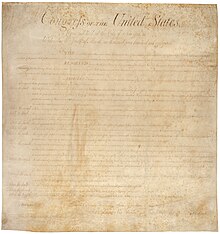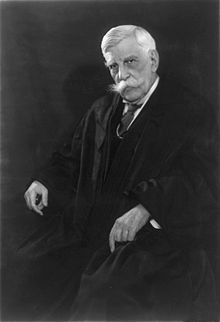
The First Amendment to the United States Constitution prevents the government from making laws that: regulate an establishment of religion; prohibit the free exercise of religion; abridge the freedom of speech, the freedom of the press, the freedom of assembly, or the right to petition the government for redress of grievances. It was adopted on December 15, 1791, as one of the ten amendments that constitute the Bill of Rights.
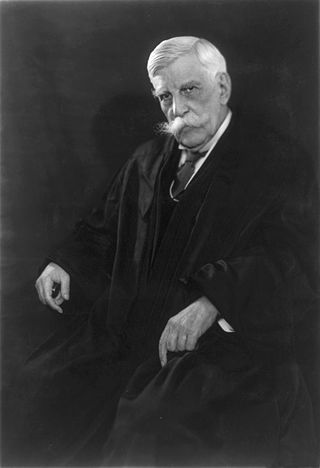
Clear and present danger was a doctrine adopted by the Supreme Court of the United States to determine under what circumstances limits can be placed on First Amendment freedoms of speech, press, or assembly. Created by Justice Oliver Wendell Holmes Jr. to refine the bad tendency test, it was never fully adopted and both tests were ultimately replaced in 1969 with Brandenburg v. Ohio's "imminent lawless action" test.
Schenck v. United States, 249 U.S. 47 (1919), was a landmark decision of the U.S. Supreme Court concerning enforcement of the Espionage Act of 1917 during World War I. A unanimous Supreme Court, in an opinion by Justice Oliver Wendell Holmes Jr., concluded that Charles Schenck, who distributed flyers to draft-age men urging resistance to induction, could be convicted of an attempt to obstruct the draft, a criminal offense. The First Amendment did not protect Schenck from prosecution, even though, "in many places and in ordinary times, Schenck, in saying all that was said in the circular, would have been within his constitutional rights. But the character of every act depends upon the circumstances in which it is done." In this case, Holmes said, "the words used are used in such circumstances and are of such a nature as to create a clear and present danger that they will bring about the substantive evils that Congress has a right to prevent." Therefore, Schenck could be punished.
Brandenburg v. Ohio, 395 U.S. 444 (1969), is a landmark decision of the United States Supreme Court interpreting the First Amendment to the U.S. Constitution. The Court held that the government cannot punish inflammatory speech unless that speech is "directed to inciting or producing imminent lawless action and is likely to incite or produce such action". Specifically, the Court struck down Ohio's criminal syndicalism statute, because that statute broadly prohibited the mere advocacy of violence. In the process, Whitney v. California (1927) was explicitly overruled, and Schenck v. United States (1919), Abrams v. United States (1919), Gitlow v. New York (1925), and Dennis v. United States (1951) were overturned.
New York Times Co. v. Sullivan, 376 U.S. 254 (1964), was a landmark U.S. Supreme Court decision ruling that the freedom of speech protections in the First Amendment to the U.S. Constitution restrict the ability of public officials to sue for defamation. The decision held that if a plaintiff in a defamation lawsuit is a public official or candidate for public office, then not only must they prove the normal elements of defamation—publication of a false defamatory statement to a third party—they must also prove that the statement was made with "actual malice", meaning the defendant either knew the statement was false or recklessly disregarded whether it might be false. New York Times Co. v. Sullivan is frequently ranked as one of the greatest Supreme Court decisions of the modern era.
Whitney v. California, 274 U.S. 357 (1927), was a United States Supreme Court decision upholding the conviction of an individual who had engaged in speech that raised a threat to society. Whitney was explicitly overruled by Brandenburg v. Ohio in 1969.
Gitlow v. New York, 268 U.S. 652 (1925), was a landmark decision of the United States Supreme Court holding that the Fourteenth Amendment to the United States Constitution had extended the First Amendment's provisions protecting freedom of speech and freedom of the press to apply to the governments of U.S. states. Along with Chicago, Burlington & Quincy Railroad Co. v. City of Chicago (1897), it was one of the first major cases involving the incorporation of the Bill of Rights. It was also one of a series of Supreme Court cases that defined the scope of the First Amendment's protection of free speech and established the standard to which a state or the federal government would be held when it criminalized speech or writing.

Oliver Wendell Holmes Jr. was an American jurist who served as an associate justice of the U.S. Supreme Court from 1902 to 1932. Holmes is one of the most widely cited Supreme Court justices and among the most influential American judges in history, noted for his long service, pithy opinions—particularly those on civil liberties and American constitutional democracy—and deference to the decisions of elected legislatures. Holmes retired from the court at the age of 90, an unbeaten record for oldest justice on the Supreme Court. He previously served as a Brevet Colonel in the American Civil War, in which he was wounded three times, as an associate justice and chief justice of the Massachusetts Supreme Judicial Court, and as Weld Professor of Law at his alma mater, Harvard Law School. His positions, distinctive personality, and writing style made him a popular figure, especially with American progressives.
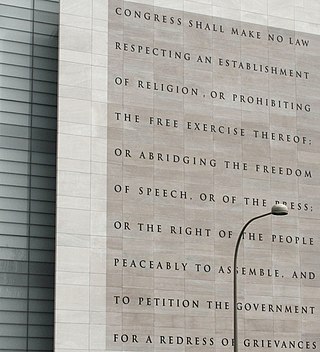
In the United States, freedom of speech and expression is strongly protected from government restrictions by the First Amendment to the U.S. Constitution, many state constitutions, and state and federal laws. Freedom of speech, also called free speech, means the free and public expression of opinions without censorship, interference and restraint by the government. The term "freedom of speech" embedded in the First Amendment encompasses the decision what to say as well as what not to say. The Supreme Court of the United States has recognized several categories of speech that are given lesser or no protection by the First Amendment and has recognized that governments may enact reasonable time, place, or manner restrictions on speech. The First Amendment's constitutional right of free speech, which is applicable to state and local governments under the incorporation doctrine, prevents only government restrictions on speech, not restrictions imposed by private individuals or businesses unless they are acting on behalf of the government. However, It can be restricted by time, place and manner in limited circumstances. Some laws may restrict the ability of private businesses and individuals from restricting the speech of others, such as employment laws that restrict employers' ability to prevent employees from disclosing their salary to coworkers or attempting to organize a labor union.

Joseph Anthony Lewis was an American public intellectual and journalist. He was a two-time winner of the Pulitzer Prize and was a columnist for The New York Times. He is credited with creating the field of legal journalism in the United States.
Abrams v. United States, 250 U.S. 616 (1919), was a decision by the Supreme Court of the United States upholding the 1918 Amendment to the Espionage Act of 1917 which made it a criminal offense to urge the curtailment of production of the materials necessary to wage the war against Germany with intent to hinder the progress of the war. The 1918 Amendment is commonly referred to as if it were a separate Act, the Sedition Act of 1918.
"Shouting fire in a crowded theater" is a popular analogy for speech or actions whose principal purpose is to create panic, and in particular for speech or actions which may for that reason be thought to be outside the scope of free speech protections. The phrase is a paraphrasing of a dictum, or non-binding statement, from Justice Oliver Wendell Holmes Jr.'s opinion in the United States Supreme Court case Schenck v. United States in 1919, which held that the defendant's speech in opposition to the draft during World War I was not protected free speech under the First Amendment of the United States Constitution. The case was later partially overturned by Brandenburg v. Ohio in 1969, which limited the scope of banned speech to that which would be directed to and likely to incite imminent lawless action.
United States v. Schwimmer, 279 U.S. 644 (1929), was a case decided by the Supreme Court of the United States. It concerned a pacifist applicant for naturalization who in the interview declared not to be willing to "take up arms personally" in defense of the United States. Originally found unable by the District Court for the Northern District of Illinois to take the prescribed oath of allegiance, a decision reversed in appeal, the case was argued before the Supreme Court, which ruled against the applicant, and thus denied her the possibility of becoming a United States citizen.
National Socialist Party of America v. Village of Skokie, 432 U.S. 43 (1977), arising out of what is sometimes referred to as the Skokie Affair, was a landmark decision of the US Supreme Court dealing with freedom of speech and freedom of assembly. This case is considered a "classic" free speech case in constitutional law classes. Related court decisions are captioned Skokie v. NSPA, Collin v. Smith, and Smith v. Collin. The Supreme Court ruled 5–4, per curiam. The Supreme Court's 1977 ruling granted certiorari and reversed and remanded the Illinois Supreme Court's denial to lift the lower court's injunction on the NSPA's march. In other words: the courts decided a person's assertion that speech is being restrained must be reviewed immediately by the judiciary. By requiring the state court to consider the neo-Nazis' appeal without delay, the U.S. Supreme Court decision opened the door to allowing the National Socialist Party of America to march.
Nebraska Press Association v. Stuart, 427 U.S. 539 (1976), was a landmark Supreme Court of the United States decision in which the Court held unconstitutional prior restraints on media coverage during criminal trials.

Louis Dembitz Brandeis was an American lawyer who served as an associate justice on the Supreme Court of the United States from 1916 to 1939.
Intellectual freedom encompasses the freedom to hold, receive and disseminate ideas without restriction. Viewed as an integral component of a democratic society, intellectual freedom protects an individual's right to access, explore, consider, and express ideas and information as the basis for a self-governing, well-informed citizenry. Intellectual freedom comprises the bedrock for freedoms of expression, speech, and the press and relates to freedoms of information and the right to privacy.
Time, Inc. v. Hill, 385 U.S. 374 (1967), is a United States Supreme Court case involving issues of privacy in balance with the First Amendment to the United States Constitution and principles of freedom of speech. The Court held 6–3 that the latter requires that merely negligent intrusions into the former by the media not be civilly actionable. It expanded that principle from its landmark defamation holding in New York Times v. Sullivan.
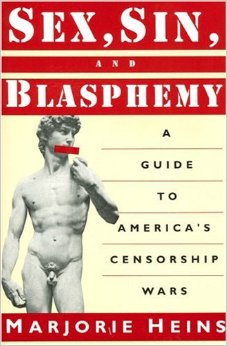
Sex, Sin, and Blasphemy: A Guide to America's Censorship Wars is a non-fiction book by lawyer and civil libertarian Marjorie Heins that is about freedom of speech and the censorship of works of art in the early 1990s by the U.S. government. The book was published in 1993 by The New Press. Heins provides an overview of the history of censorship, including the 1873 Comstock laws, and then moves on to more topical case studies of attempts at suppression of free expression.
Hate speech in the United States cannot be directly regulated by the government due to the fundamental right to freedom of speech protected by the Constitution. While "hate speech" is not a legal term in the United States, the U.S. Supreme Court has repeatedly ruled that most of what would qualify as hate speech in other western countries is legally protected speech under the First Amendment. In a Supreme Court case on the issue, Matal v. Tam (2017), the justices unanimously reaffirmed that there is effectively no "hate speech" exception to the free speech rights protected by the First Amendment and that the U.S. government may not discriminate against speech on the basis of the speaker's viewpoint.

